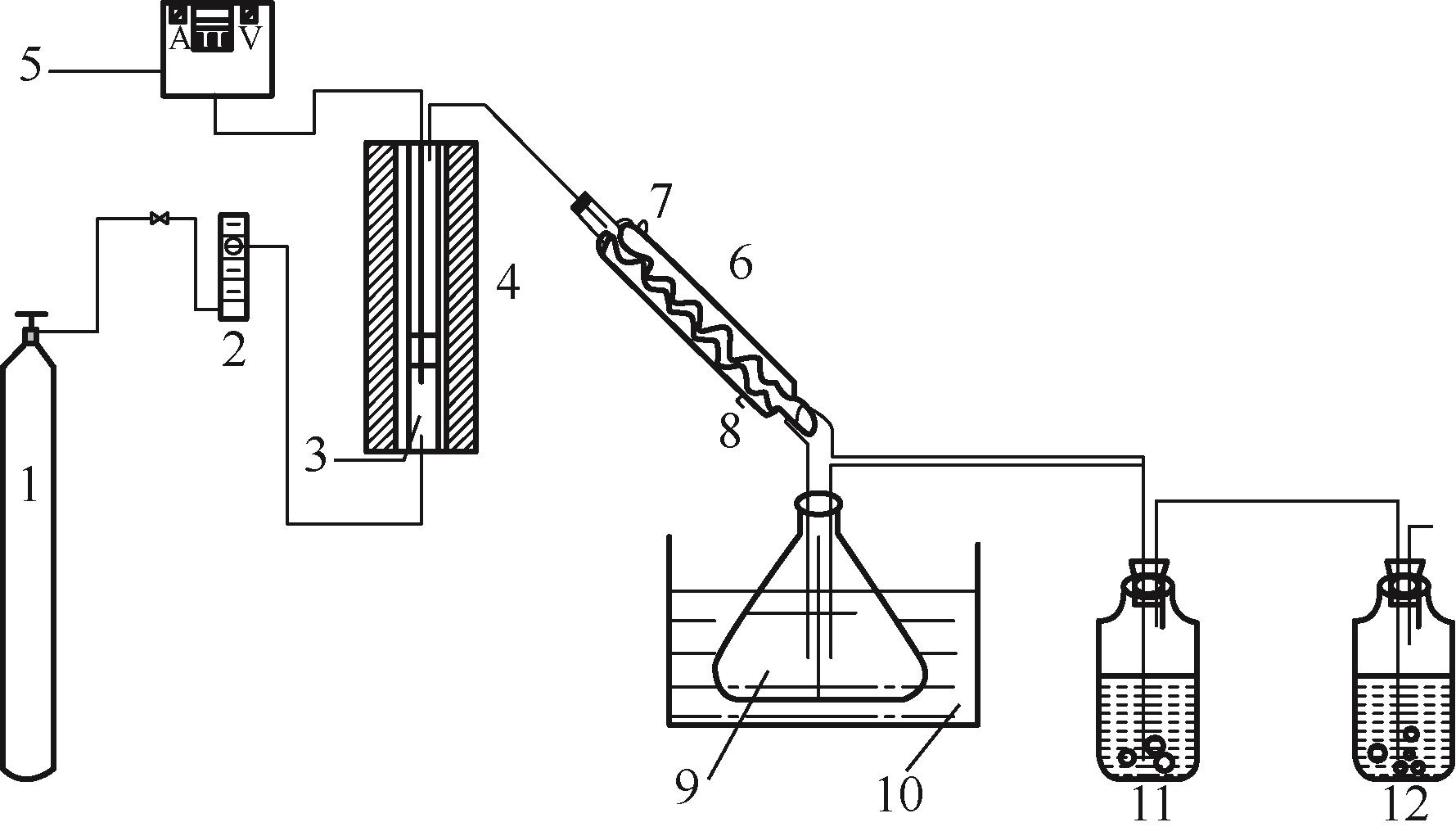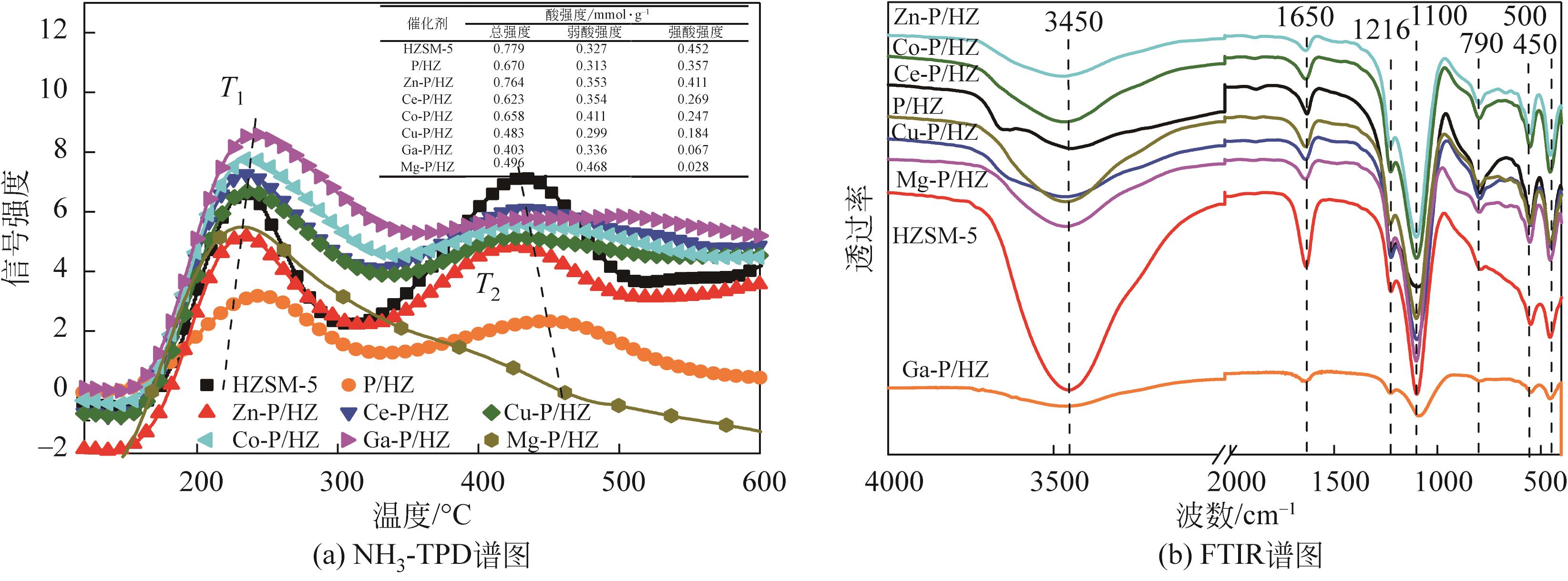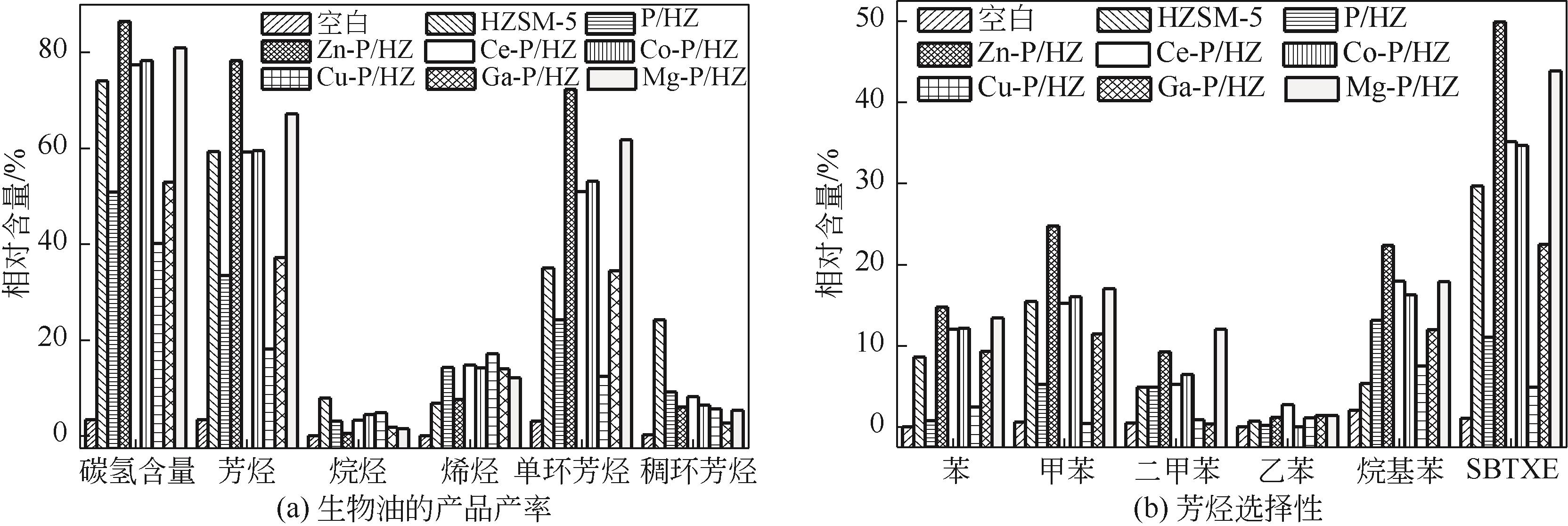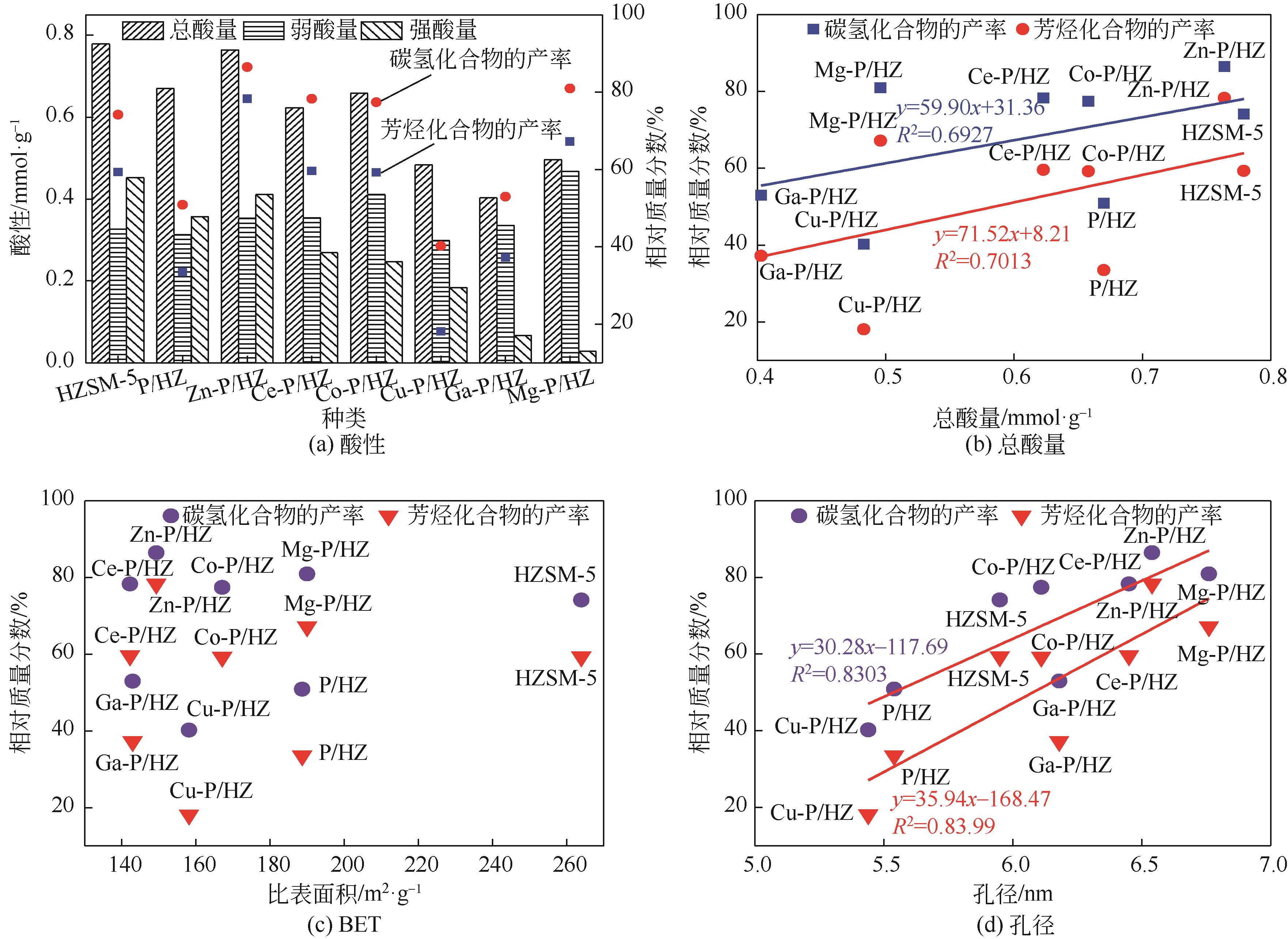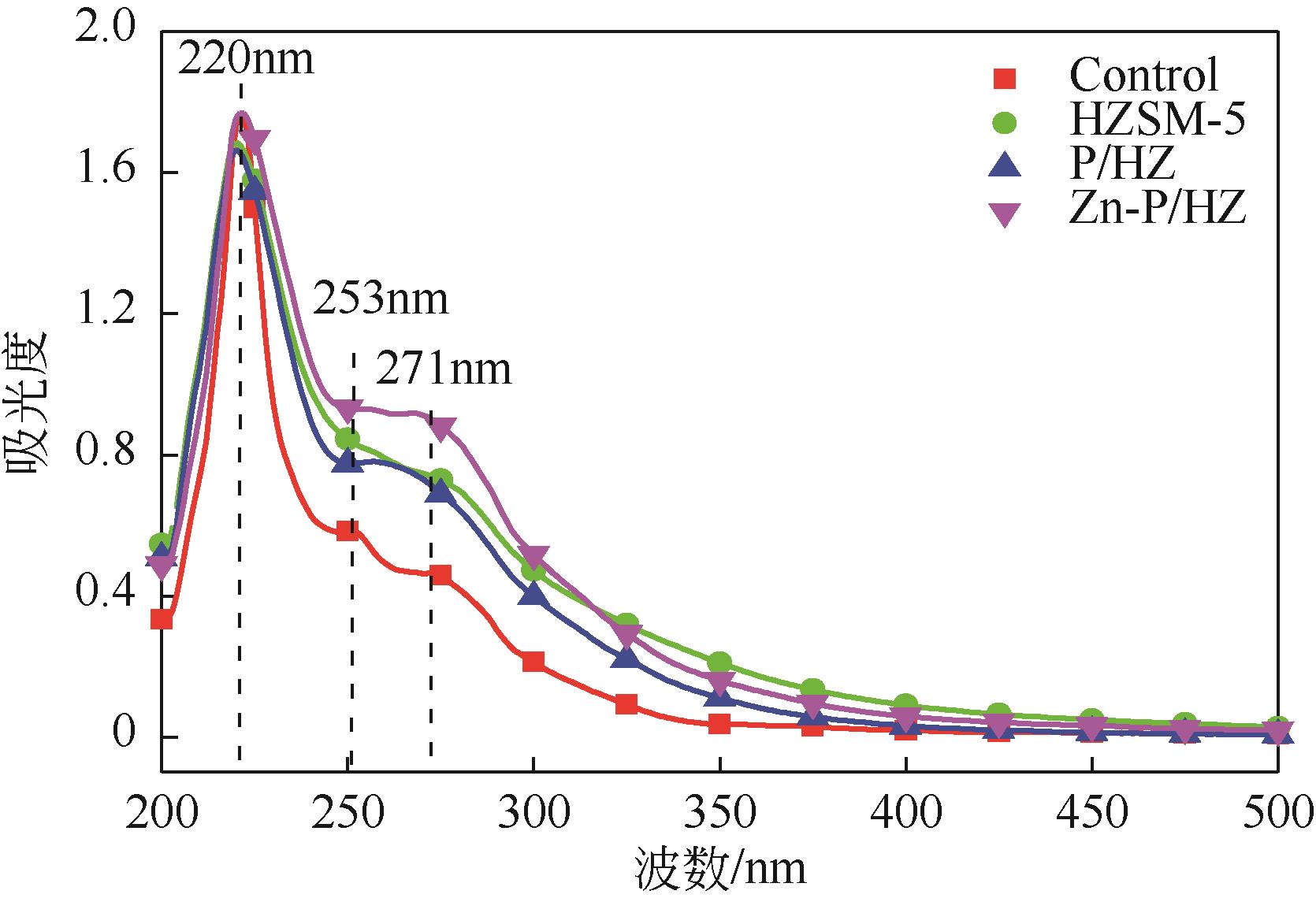Chemical Industry and Engineering Progress ›› 2023, Vol. 42 ›› Issue (3): 1353-1364.DOI: 10.16085/j.issn.1000-6613.2022-0865
• Industrial catalysis • Previous Articles Next Articles
Production of hydrocarbon-rich bio-oil by catalytic biomass pyrolysis over metal oxide improved P/HZSM-5 catalyst
ZHENG Yunwu1,2( ), PEI Tao1,2, LI Donghua1,2, WANG Jida1,2, LI Jirong1,2, ZHENG Zhifeng1,3(
), PEI Tao1,2, LI Donghua1,2, WANG Jida1,2, LI Jirong1,2, ZHENG Zhifeng1,3( )
)
- 1.National Joint Engineering Research Center for Highly-Efficient Utilization Technology of Forest Biomass Resources, Southwest Forestry University, Kunming 650224, Yunnan, China
2.College of Materials Science and Engineering, Southwest Forestry University, Kunming 650224, Yunnan, China
3.Xiamen Key Laboratory for High-valued Conversion Technology of Agricultural Biomass (Xiamen University), Fujian Provincial Engineering and Research Center of Clean and High-valued Technologies for Biomass, College of Energy, Xiamen University, Xiamen 361102, Fujian, China
-
Received:2022-05-10Revised:2022-07-07Online:2023-04-10Published:2023-03-15 -
Contact:ZHENG Zhifeng
金属氧化物活化P/HZSM-5催化生物质热解气重整制备富烃生物油
郑云武1,2( ), 裴涛1,2, 李冬华1,2, 王继大1,2, 李继容1,2, 郑志锋1,3(
), 裴涛1,2, 李冬华1,2, 王继大1,2, 李继容1,2, 郑志锋1,3( )
)
- 1.西南林业大学林业生物质资源高效利用技术国家地方联合工程研究中心,云南 昆明 650224
2.西南林业大学材料科学与工程学院,云南 昆明 650224
3.厦门市现代农业生物质高值化技术重点实验室(厦门大学),福建省生物质高值化技术工程研究中心(厦门大学),厦门大学能源学院,福建 厦门 361102
-
通讯作者:郑志锋 -
作者简介:郑云武(1983—),男,博士,副教授,硕士生导师,研究方向为生物质热化学转化。E-mail:zyw85114@163.com。 -
基金资助:国家重点研发计划(2019YFD1002404);国家自然科学基金(31670599);云南省高等学校大学生创新创业项目
CLC Number:
Cite this article
ZHENG Yunwu, PEI Tao, LI Donghua, WANG Jida, LI Jirong, ZHENG Zhifeng. Production of hydrocarbon-rich bio-oil by catalytic biomass pyrolysis over metal oxide improved P/HZSM-5 catalyst[J]. Chemical Industry and Engineering Progress, 2023, 42(3): 1353-1364.
郑云武, 裴涛, 李冬华, 王继大, 李继容, 郑志锋. 金属氧化物活化P/HZSM-5催化生物质热解气重整制备富烃生物油[J]. 化工进展, 2023, 42(3): 1353-1364.
share this article
Add to citation manager EndNote|Ris|BibTeX
URL: https://hgjz.cip.com.cn/EN/10.16085/j.issn.1000-6613.2022-0865
| 催化剂试样 | 比表面积SBET /m2·g-1 | 微孔表面积Smicro /m2·g-1 | 外表面积Sext /m2·g-1 | 总孔容Vtotal /mL·g-1 | 介孔孔容Vmeso /mL·g-1 | 微孔孔容Vmicro /mL·g-1 | 平均孔径Dpore size /nm-1 |
|---|---|---|---|---|---|---|---|
| HZSM-5 | 263.99 | 116.92 | 147.08 | 0.2522 | 0.1914 | 0.06083 | 5.95 |
| P/HZ | 188.67 | 116.01 | 70.22 | 0.1774 | 0.1171 | 0.06034 | 5.54 |
| Zn-P/HZ | 149.27 | 107.40 | 41.88 | 0.1158 | 0.05999 | 0.05581 | 6.54 |
| Ce-P/HZ | 142.23 | 104.81 | 37.43 | 0.1053 | 0.05088 | 0.05442 | 6.45 |
| Co-P/HZ | 167.06 | 140.96 | 26.09 | 0.1119 | 0.03886 | 0.07304 | 6.11 |
| Cu-P/HZ | 158.15 | 119.28 | 38.86 | 0.1087 | 0.04674 | 0.06196 | 5.44 |
| Ga-P/HZ | 142.91 | 100.77 | 42.14 | 0.1110 | 0.05862 | 0.05238 | 5.18 |
| Mg-P/HZ | 169.99 | 102.81 | 67.17 | 0.1283 | 0.06955 | 0.05875 | 6.76 |
| 催化剂试样 | 比表面积SBET /m2·g-1 | 微孔表面积Smicro /m2·g-1 | 外表面积Sext /m2·g-1 | 总孔容Vtotal /mL·g-1 | 介孔孔容Vmeso /mL·g-1 | 微孔孔容Vmicro /mL·g-1 | 平均孔径Dpore size /nm-1 |
|---|---|---|---|---|---|---|---|
| HZSM-5 | 263.99 | 116.92 | 147.08 | 0.2522 | 0.1914 | 0.06083 | 5.95 |
| P/HZ | 188.67 | 116.01 | 70.22 | 0.1774 | 0.1171 | 0.06034 | 5.54 |
| Zn-P/HZ | 149.27 | 107.40 | 41.88 | 0.1158 | 0.05999 | 0.05581 | 6.54 |
| Ce-P/HZ | 142.23 | 104.81 | 37.43 | 0.1053 | 0.05088 | 0.05442 | 6.45 |
| Co-P/HZ | 167.06 | 140.96 | 26.09 | 0.1119 | 0.03886 | 0.07304 | 6.11 |
| Cu-P/HZ | 158.15 | 119.28 | 38.86 | 0.1087 | 0.04674 | 0.06196 | 5.44 |
| Ga-P/HZ | 142.91 | 100.77 | 42.14 | 0.1110 | 0.05862 | 0.05238 | 5.18 |
| Mg-P/HZ | 169.99 | 102.81 | 67.17 | 0.1283 | 0.06955 | 0.05875 | 6.76 |
| 序号 | 催化剂的种类 | 热解温度/℃ | 产物组成 | 产品产率/% | 参考文献 |
|---|---|---|---|---|---|
| 1 | HZSM-5/赤泥 | 475 | 芳烃 | 53.44 | [ |
| 2 | HZSM-5/MCM-41 | 600 | 芳烃 | 41.44 | [ |
| 3 | HZSM-5 | 600 | 芳烃 | 34.41 | [ |
| 4 | CaO@HZSM-5 | 550 | 芳烃 | 31.34 | [ |
| 5 | TiO2@HZSM-5 | 550 | BTX | 23.58 | [ |
| 6 | HZSM-5 | 550 | BTX | 16.96 | [ |
| 7 | CeO2-ZrO2-Al2O3 | 600 | 芳烃 | 20.23 | [ |
| 8 | ZnO@HZSM-5 | 500 | 芳烃 | 72.28 | 本研究 |
| 序号 | 催化剂的种类 | 热解温度/℃ | 产物组成 | 产品产率/% | 参考文献 |
|---|---|---|---|---|---|
| 1 | HZSM-5/赤泥 | 475 | 芳烃 | 53.44 | [ |
| 2 | HZSM-5/MCM-41 | 600 | 芳烃 | 41.44 | [ |
| 3 | HZSM-5 | 600 | 芳烃 | 34.41 | [ |
| 4 | CaO@HZSM-5 | 550 | 芳烃 | 31.34 | [ |
| 5 | TiO2@HZSM-5 | 550 | BTX | 23.58 | [ |
| 6 | HZSM-5 | 550 | BTX | 16.96 | [ |
| 7 | CeO2-ZrO2-Al2O3 | 600 | 芳烃 | 20.23 | [ |
| 8 | ZnO@HZSM-5 | 500 | 芳烃 | 72.28 | 本研究 |
| 试样 | C/% | H/% | O/% | N/% | S/% | H/C | O/C | 热值/MJ·kg-1 | 脱氧效率/% | 有效氢碳比 | 重整常数/% |
|---|---|---|---|---|---|---|---|---|---|---|---|
| 热解油 | 52.14 | 6.48 | 40.71 | 0.55 | 0.12 | 0.124 | 0.781 | 21.63 | 0 | 0.2913 | 0 |
| HZSM-5 | 66.73 | 7.83 | 25.05 | 0.28 | 0.11 | 0.117 | 0.375 | 29.94 | 73.23 | 0.8329 | 2.3587 |
| P/HZ | 64.99 | 7.64 | 26.91 | 0.33 | 0.13 | 0.118 | 0.414 | 28.92 | 49.14 | 0.7750 | 0.7752 |
| Zn-P/HZ | 69.88 | 8.01 | 21.63 | 0.38 | 0.10 | 0.115 | 0.310 | 31.60 | 85.98 | 0.8961 | 5.6908 |
| Ce-P/HZ | 69.26 | 7.82 | 22.56 | 0.27 | 0.09 | 0.113 | 0.326 | 31.07 | 77.54 | 0.8553 | 3.0561 |
| Co-P/HZ | 67.91 | 6.73 | 24.76 | 0.44 | 0.16 | 0.099 | 0.365 | 29.09 | 76.60 | 0.6239 | 2.1147 |
| Cu-P/HZ | 60.02 | 6.96 | 32.63 | 0.28 | 0.11 | 0.116 | 0.544 | 25.79 | 38.12 | 0.5627 | 0.3588 |
| Ga-P/HZ | 65.13 | 6.58 | 27.74 | 0.47 | 0.08 | 0.101 | 0.426 | 27.62 | 51.33 | 0.5540 | 0.6047 |
| Mg-P/HZ | 68.62 | 7.75 | 23.33 | 0.22 | 0.08 | 0.113 | 0.340 | 30.68 | 80.26 | 0.8362 | 3.5192 |
| 试样 | C/% | H/% | O/% | N/% | S/% | H/C | O/C | 热值/MJ·kg-1 | 脱氧效率/% | 有效氢碳比 | 重整常数/% |
|---|---|---|---|---|---|---|---|---|---|---|---|
| 热解油 | 52.14 | 6.48 | 40.71 | 0.55 | 0.12 | 0.124 | 0.781 | 21.63 | 0 | 0.2913 | 0 |
| HZSM-5 | 66.73 | 7.83 | 25.05 | 0.28 | 0.11 | 0.117 | 0.375 | 29.94 | 73.23 | 0.8329 | 2.3587 |
| P/HZ | 64.99 | 7.64 | 26.91 | 0.33 | 0.13 | 0.118 | 0.414 | 28.92 | 49.14 | 0.7750 | 0.7752 |
| Zn-P/HZ | 69.88 | 8.01 | 21.63 | 0.38 | 0.10 | 0.115 | 0.310 | 31.60 | 85.98 | 0.8961 | 5.6908 |
| Ce-P/HZ | 69.26 | 7.82 | 22.56 | 0.27 | 0.09 | 0.113 | 0.326 | 31.07 | 77.54 | 0.8553 | 3.0561 |
| Co-P/HZ | 67.91 | 6.73 | 24.76 | 0.44 | 0.16 | 0.099 | 0.365 | 29.09 | 76.60 | 0.6239 | 2.1147 |
| Cu-P/HZ | 60.02 | 6.96 | 32.63 | 0.28 | 0.11 | 0.116 | 0.544 | 25.79 | 38.12 | 0.5627 | 0.3588 |
| Ga-P/HZ | 65.13 | 6.58 | 27.74 | 0.47 | 0.08 | 0.101 | 0.426 | 27.62 | 51.33 | 0.5540 | 0.6047 |
| Mg-P/HZ | 68.62 | 7.75 | 23.33 | 0.22 | 0.08 | 0.113 | 0.340 | 30.68 | 80.26 | 0.8362 | 3.5192 |
| 1 | HOANG AT, ONG H C, FATTAH I R, et al. Progress on the lignocellulosic biomass pyrolysis for biofuel production toward environmental sustainability[J]. Fuel Processing Technology, 2021, 223: 106997. |
| 2 | TAWALBEH M, AL-OTHMAN A, SALAMAH T, et al. A critical review on metal-based catalysts used in the pyrolysis of lignocellulosic biomass materials[J]. Journal of Environmental Management, 2021, 299: 113597. |
| 3 | JIN Y, LIU J, YANG H, et al. Improving enzymatic saccharification and ethanol production of bamboo residues with sulfomethylation-aided phosphoric acid pretreatment[J]. Industrial Crops and Products, 2021, 170: 113733. |
| 4 | LI N, MENG F, YANG H, et al. Enhancing enzymatic digestibility of bamboo residues using a three-constituent deep eutectic solvent pretreatment[J]. Bioresource Technology, 2022, 346:126639. |
| 5 | DADA T K, SHEEHAN M, MURUGAVELH S, et al. A review on catalytic pyrolysis for high-quality bio-oil production from biomass[J]. Biomass Conversion and Biorefinery, 2021: 1-20. |
| 6 | BALASUNDRAM V, IBRAHIM N, KASMANI R M, et al. Catalytic upgrading of biomass-derived pyrolysis vapour over metal-modified HZSM-5 into BTX: A comprehensive review[J]. Biomass Conversion and Biorefinery, 2022, 12(5): 1911-1938. |
| 7 | ZHENG Y W, WANG J D, WANG D C, et al. Advanced catalytic upgrading of biomass pyrolysis vapor to bio-aromatics hydrocarbon: A review[J]. Applications in Energy and Combustion Science, 2022,10: 100061. |
| 8 | LIU R H, RAHMAN M M, SARKER M, et al. A review on the catalytic pyrolysis of biomass for the bio-oil production with ZSM-5: Focus on structure[J]. Fuel Processing Technology, 2020, 199: 106301. |
| 9 | SERAPIGLIA M J, MULLEN C A, SMART L B, et al. Variability in pyrolysis product yield from novel shrub willow genotypes[J]. Biomass and Bioenergy, 2015, 72: 74-84. |
| 10 | TEIMOURISENDESI S M, TOWFIGHI J, KEYVANLOO K. The effect of Fe, P and Si/Al molar ratio on stability of HZSM-5 catalyst in naphtha thermal-catalytic cracking to light olefins[J]. Catalysis Communications, 2012, 27: 114-118. |
| 11 | BUTTER S A, KAEDING W W. Phosphorus-containing zeolite catalyst: US3972832[P]. 1976-08-03. |
| 12 | LIANG J, SHAN G C, SUN Y F. Catalytic fast pyrolysis of lignocellulosic biomass: Critical role of zeolite catalysts[J]. Renewable and Sustainable Energy Reviews, 2021, 139: 110707. |
| 13 | JIN T, WANG H T, PENG J B, et al. Catalytic pyrolysis of lignin with metal-modified HZSM-5 as catalysts for monocyclic aromatic hydrocarbons production[J]. Fuel Processing Technology, 2022, 230: 107201. |
| 14 | ZHENG Y W, WANG F, YANG X Q, et al. Study on aromatics production via the catalytic pyrolysis vapor upgrading of biomass using metal-loaded modified H-ZSM-5[J]. Journal of Analytical and Applied Pyrolysis, 2017, 126: 169-179. |
| 15 | LI X H, CHEN L, FAN Y S, et al. Study on preparation of refined oil by upgrading of pyrolytic vapors using Zn-P/HZSM-5 zeolite[J]. Journal of Fuel Chemistry and Technology, 2015, 43(5): 567-574. |
| 16 | FAN Y S, HOU G X, LU D S, et al. A novel production of aromatic hydrocarbons via dielectric barrier discharge assisted one-stage pyrolysis-catalysis of biomass: Insights into modified HZSM-5 selectivity and stability[J]. Journal of Analytical and Applied Pyrolysis, 2022, 161: 105417. |
| 17 | KIM J W, PARK S H, JUNG J, et al. Catalytic pyrolysis of mandarin residue from the mandarin juice processing industry[J]. Bioresource Technology, 2013, 136: 431-436. |
| 18 | ZHANG L D, GAO J H, HU J X, et al. Lanthanum oxides-improved catalytic performance of ZSM-5 in toluene alkylation with methanol[J]. Catalysis Letters, 2009, 130(3/4): 355-361. |
| 19 | LIU C J, WANG H M, KARIM A M, et al. Catalytic fast pyrolysis of lignocellulosic biomass[J]. Chemical Society Reviews, 2014, 43(22) :7594-7623. |
| 20 | OSEKE G G, ATTA A Y, MUKHTAR B, et al. Highly selective and stable Zn-Fe/ZSM-5 catalyst for aromatization of propane[J]. Applied Petrochemical Research, 2020, 10(2): 55-65. |
| 21 | 葛笑, 苟进胜. 金属改性HZSM-5催化快速热解木聚糖制备芳烃化合物[J]. 包装工程, 2021, 42(21): 105-112. |
| GE Xiao, GOU Jinsheng. Catalytic fast pyrolysis of xylan to aromatic compounds by metal modified HZSM-5[J]. Packaging Engineering, 2021, 42(21): 105-112. | |
| 22 | HUANG M, MA Z Q, ZHOU B L, et al. Enhancement of the production of bio-aromatics from renewable lignin by combined approach of torrefaction deoxygenation pretreatment and shape selective catalytic fast pyrolysis using metal modified zeolites[J]. Bioresource Technology, 2020, 30: 122754. |
| 23 | NEUMANN G T, HICKS J C. Novel hierarchical cerium-incorporated MFI zeolite catalysts for the catalytic fast pyrolysis of lignocellulosic biomass[J]. ACS Catalysis, 2012, 2(4): 642-646. |
| 24 | 黄明, 朱亮, 马中青, 等. 金属改性分子筛催化热解木质素制取轻质芳烃[J]. 燃料化学学报, 2021, 49(3): 292-302. |
| HUANG Ming, ZHU Liang, MA Zhongqing, et al. Production of light aromatics from the fast pyrolysis of lignin catalyzed by metal modified H-ZSM-5 zeolites[J]. Journal of Fuel Chemistry and Technology, 2021, 49(3): 292-302. | |
| 25 | VESES A, PUÉRTOLAS B, LÓPEZ J M, et al. Promoting deoxygenation of bio-oil by metal-loaded hierarchical ZSM-5 zeolites[J]. ACS Sustainable Chemistry & Engineering, 2016, 4(3): 1653-1660. |
| 26 | CHENG S Y, WEI L, ZHAO X H, et al. Conversion of prairie cordgrass to hydrocarbon biofuel over Co-Mo/HZSM-5 using a two-stage reactor system[J]. Energy Technology, 2016, 4(6): 706-713. |
| 27 | FATHI S, SOHRABI M, FALAMAKI C. Improvement of HZSM-5 performance by alkaline treatments: Comparative catalytic study in the MTG reactions[J]. Fuel, 2014, 116: 529-537. |
| 28 | LIU J N, XIANG M, WU D F. Enhanced phenol hydrodeoxygenation over a Ni catalyst supported on a mixed mesoporous ZSM-5 zeolite and Al2O3 [J]. Catalysis Letters, 2017, 147(10): 2498-2507. |
| 29 | ZHENG Y W, WANG J D, LI D H, et al. Activity and selectivity of Ni-Cu bimetallic zeolites catalysts on biomass conversion for bio-aromatic and bio-phenols[J]. Journal of the Energy Institute, 2021, 97: 58-72. |
| 30 | LIU C C, USLAMIN E A, KHRAMENKOVA E, et al. High stability of methanol to aromatic conversion over bimetallic Ca, Ga-modified ZSM-5[J]. ACS Catalysis, 2022, 12(5): 3189-3200. |
| 31 | DING K, ZHONG Z P, WANG J, et al. Improving hydrocarbon yield from catalytic fast co-pyrolysis of hemicellulose and plastic in the dual-catalyst bed of CaO and HZSM-5[J]. Bioresource Technology, 2018, 261: 86-92. |
| 32 | YANG M F, SHAO J G, YANG H P, et al. Enhancing the production of light olefins and aromatics from catalytic fast pyrolysis of cellulose in a dual-catalyst fixed bed reactor[J]. Bioresource Technology, 2019, 273: 77-85. |
| 33 | KARNJANAKOM S, BAYU A, HAO X G, et al. Selectively catalytic upgrading of bio-oil to aromatic hydrocarbons over Zn, Ce or Ni-doped mesoporous rod-like alumina catalysts[J]. Journal of Molecular Catalysis A: Chemical, 2016, 421: 235-244. |
| 34 | LY H V, PARK J W, KIM S S, et al. Catalytic pyrolysis of bamboo in a bubbling fluidized-bed reactor with two different catalysts: HZSM-5 and red mud for upgrading bio-oil[J]. Renewable Energy, 2020, 149: 1434-1445. |
| 35 | LI Z Y, ZHONG Z P, ZHANG B, et al. Catalytic fast pyrolysis of bamboo over micro-mesoporous composite molecular sieves[J]. Energy Technology, 2018, 6(4): 728-736. |
| 36 | WANG J, ZHONG Z P, DING K, et al. Catalytic fast pyrolysis of bamboo sawdust via a two-step bench scale bubbling fluidized bed/fixed bed reactor: Study on synergistic effect of alkali metal oxides and HZSM-5[J]. Energy Conversion and Management, 2018,176: 287-298. |
| 37 | DU H R, ZHONG Z P, ZHANG B, et al. Ex-situ catalytic upgrading of vapors from microwave-assisted pyrolysis of bamboo with chemical liquid deposition modified HZSM-5 to enhance aromatics production[J]. Journal of Analytical and Applied Pyrolysis, 2020,149: 104857. |
| 38 | XUE Z Y, ZHONG Z P, ZHANG B, et al. Performance of catalytic fast pyrolysis using a γ-Al2O3 catalyst with compound modification of ZrO2 and CeO2 [J]. Catalysts, 2019, 9(10): 849. |
| 39 | QUAN C, GAO N B, SONG Q B. Pyrolysis of biomass components in a TGA and a fixed-bed reactor: Thermochemical behaviors, kinetics, and product characterization[J]. Journal of Analytical and Applied Pyrolysis, 2016, 121: 84-92. |
| 40 | ZHAO C, HE J Y, LEMONIDOU A A, et al. Aqueous-phase hydrodeoxygenation of bio-derived phenols to cycloalkanes[J]. Journal of Catalysis, 2011, 280(1): 8-16. |
| 41 | JAE J, TOMPSETT G A, FOSTER A J, et al. Investigation into the shape selectivity of zeolite catalysts for biomass conversion[J]. Journal of Catalysis, 2011, 279(2): 257-268. |
| 42 | CHEN W, WESTERHOFF P, LEENHEER J A, et al. Fluorescence excitation-emission matrix regional integration to quantify spectra for dissolved organic matter[J]. Environmental Science & Technology, 2003, 37(24): 5701-5710. |
| 43 | LI C, SUN Y F, YI Z J, et al. Co-pyrolysis of coke bottle wastes with cellulose, lignin and sawdust: Impacts of the mixed feedstock on char properties[J]. Renewable Energy, 2022, 181: 1126-1139. |
| [1] | WANG Shuaiqing, YANG Siwen, LI Na, SUN Zhanying, AN Haoran. Research progress on element doped biomass carbon materials for electrochemical energy storage [J]. Chemical Industry and Engineering Progress, 2023, 42(8): 4296-4306. |
| [2] | YANG Jing, LI Bo, LI Wenjun, LIU Xiaona, TANG Liuyuan, LIU Yue, QIAN Tianwei. Degradation of naphthalene by degrading bacteria isolated from coking contaminated sites [J]. Chemical Industry and Engineering Progress, 2023, 42(8): 4351-4361. |
| [3] | WU Ya, ZHAO Dan, FANG Rongmiao, LI Jingyao, CHANG Nana, DU Chunbao, WANG Wenzhen, SHI Jun. Research progress on highly efficient demulsifiers for complex crude oil emulsions and their applications [J]. Chemical Industry and Engineering Progress, 2023, 42(8): 4398-4413. |
| [4] | ZHENG Mengqi, WANG Chengye, WANG Yan, WANG Wei, YUAN Shoujun, HU Zhenhu, HE Chunhua, WANG Jie, MEI Hong. Application and prospect of algal-bacterial symbiosis technology in zero liquid discharge of industrial wastewater [J]. Chemical Industry and Engineering Progress, 2023, 42(8): 4424-4431. |
| [5] | GUAN Hongling, YANG Hui, JING Hongquan, LIU Yuqiong, GU Shouyu, WANG Haobin, HOU Cuihong. Lignin-based controlled release materials and application in drug delivery and fertilizer controlled-release [J]. Chemical Industry and Engineering Progress, 2023, 42(7): 3695-3707. |
| [6] | LIU Baicheng, LI Fayun, ZHAO Qihui, LIN Meixia. Research progress on remediation of polycyclic aromatic hydrocarbons contaminated soil by Gramineae plants [J]. Chemical Industry and Engineering Progress, 2023, 42(7): 3736-3748. |
| [7] | TAN Lipeng, SHEN Jun, WANG Yugao, LIU Gang, XU Qingbai. Research progress on blending modification of coal tar pitch and petroleum asphalt [J]. Chemical Industry and Engineering Progress, 2023, 42(7): 3749-3759. |
| [8] | YU Dingyi, LI Yuanyuan, WANG Chenyu, JI Yongsheng. Preparation of lignin-based pH responsive hydrogel and its application in controlled drug release [J]. Chemical Industry and Engineering Progress, 2023, 42(6): 3138-3146. |
| [9] | WU Fengzhen, LIU Zhiwei, XIE Wenjie, YOU Yating, LAI Rouqiong, CHEN Yandan, LIN Guanfeng, LU Beili. Preparation of biomass derived Fe/N co-doped porous carbon and its application for catalytic degradation of Rhodamine B via peroxymonosulfate activation [J]. Chemical Industry and Engineering Progress, 2023, 42(6): 3292-3301. |
| [10] | WANG Xue, XU Qiyong, ZHANG Chao. Hydrothermal carbonization of the lignocellulosic biomass and application of the hydro-char [J]. Chemical Industry and Engineering Progress, 2023, 42(5): 2536-2545. |
| [11] | WANG Zhiwei, GUO Shuaihua, WU Mengge, CHEN Yan, ZHAO Junting, LI Hui, LEI Tingzhou. Recent advances on catalytic co-pyrolysis of biomass and plastic [J]. Chemical Industry and Engineering Progress, 2023, 42(5): 2655-2665. |
| [12] | LIU Jing, LIN Lin, ZHANG Jian, ZHAO Feng. Research progress in pore size regulation and electrochemical performance of biomass-based carbon materials [J]. Chemical Industry and Engineering Progress, 2023, 42(4): 1907-1916. |
| [13] | WAN Maohua, ZHANG Xiaohong, AN Xingye, LONG Yinying, LIU Liqin, GUAN Min, CHENG Zhengbai, CAO Haibing, LIU Hongbin. Research progress on the applications of MXene in the fields of biomass based energy storage nanomaterials [J]. Chemical Industry and Engineering Progress, 2023, 42(4): 1944-1960. |
| [14] | YANG Ziqiang, LI Fenghai, GUO Weijie, MA Mingjie, ZHAO Wei. Review on phosphorus migration and transformation during municipal sewage sludge heat treatment [J]. Chemical Industry and Engineering Progress, 2023, 42(4): 2081-2090. |
| [15] | XING Xianjun, LUO Tian, BU Yuzheng, MA Peiyong. Preparation of biochar from walnut shells activated by H3PO4 and its application in Cr(Ⅵ) adsorption [J]. Chemical Industry and Engineering Progress, 2023, 42(3): 1527-1539. |
| Viewed | ||||||
|
Full text |
|
|||||
|
Abstract |
|
|||||
